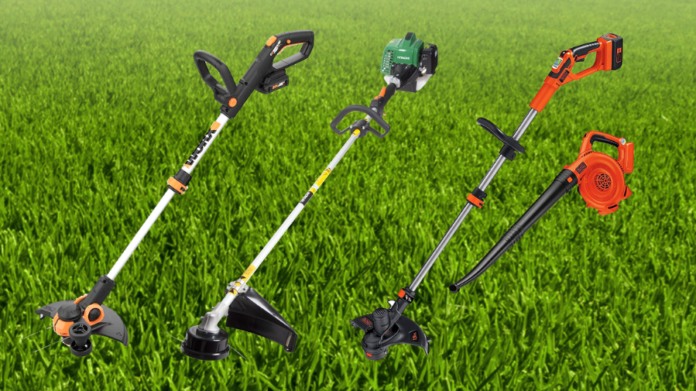The common name for weed eaters is string trimmers and there are a variety of models being sold in the market. You can buy an electric one, a gasoline one, or the battery-operated one. But all of them make for a versatile, lightweight, and powerful tool that is employed for getting rid of grass and weeds in your gardens.
Weed eaters generally come with a spinning head attached to the bottom end of a long shaft. The spinning head has a microfilament string that becomes firm to cut weeds and grass. Many models feed new strings automatically when the old ones wear out. Then eliminating the need for metal blades that require sharpening. Mechanically, the spring trimmer works similarly to a handheld lawnmower.
Table of Contents
Design

Weed eaters work on the principle that when a string is spun swiftly. It is held out from the rotating reel (it’s center) very firmly by centrifugal force. And the quicker the hub turns, the firmer or stiffer is the line. These techniques enable even a nylon line trim grass and weeds. You have to wind the line onto the reel before beginning the job; leaving both ends of the line extending from reel housing through holes. If you want to use the machine for vertical cutting; you can either tilt it or buy the one that allows you to adjust its head at various angles.
When you turn on the weed eater, its motor turns the reel, which extends the line horizontally while you move the trimmer where you want to trim the plain. You will be controlling its height and can even trim down to the ground level easily. Your garden may have a fence, poles, and other obstacles that can damage the string. But as the string breaks off or is worn; you can knock the reel on the ground so that a release mechanism lets some of the string in the reel to resupply the spent portion.
Advanced models have auto-feed. This ensures that a small cutter makes sure that the new length does not exceed than manageable length. This new line will operate more efficiently due to its heavier weights as well as surface effects. You can control the speed of the spinning hub by a throttle or trigger on the handle.
Engine Operation
The heavier or the most powerful weed eaters have 2-cycle gasoline engines that utilize a mixture of oil and gas. You have to pull a cord to turn the engine on. By doing so, the permanent magnets on flywheel energize the ignition coil that sends current to spark plug. It starts to fire with each revolution of flywheel. This ignites fuel in the combustion chamber, and driving the crankshaft.
In a battery-operated or electric model, the electric current causes the flywheel to rotate as well as drive crankshaft. In the case of start-gas powered models, you have to pull the starter cord. On the other hand, battery-powered and electric weed eaters come to life just as they have power.
Combustion
Weed eaters powered by internal combustion engines have engines on the opposite side of the shaft from cutting head. In the case of electric string trimmers, the motor is present in the cutting head. However, there can be other arrangements as well. This includes the ones where the trimmer is powered by a Chromoly hydraulic motor and connected to heavy machinery.
Gasoline-powered weed eaters have disadvantages that notable vibration is carried out throughout the device and they are heavier. Both of these issues interfere with the device’s maneuverability. This may cause muscle fatigue, and have a need for the addition of motor oil. However, they offer complete mobility because they do not have to be connected to a power outlet.
In the case of electric weed eaters, you have to make sure they are always connected to a plug point. Battery-operated ones also need to be recharged after a specific amount of usage. You would not be trimming your lawn on a regular basis. When you finally wish to trim the garden on a Sunday; finding out that your weed eater has run out of power would be disappointing because recharging it again would take time. So, gasoline-powered devices are more preferred.
Trimmer Head, Drive Shaft, And Clutch

The engine crankshaft of a weed eater connects to a centrifugal clutch, and, this connects to drive shaft that extends from the machine’s shaft to the trimmer head. A weed eater’s clutch has wings that stay retracted when its engine is idling. When the trigger is pulled to engage the throttle, those wings splay outward as well as engage drive shaft. This begins to turn the trimmer head. At maximum speed, the strings’ ends can move up to 28,000 feet/minute, which gives them enough momentum to cut through weeds and grass easily.
The trimmer head, fixed onto a spindle joined to drive shaft, is that part of the machine which holds the string. It contains a spool on which the line is wound around along with a cap that has holes from which the string protrudes.
Some weed eaters have mechanisms that advance the string automatically when it wears out. While other machines have mechanisms that advance string when you bump the cap on the ground. You can wind new string by first removing the cap, spool from the head as well. You can even replace the whole head.
Although using weed eaters seems to be easy and safe, you must wear protective clothing. You may want to wear a pair of thick pants instead of cotton shorts because debris, thorns, and stems would be hitting you with a lot of speed and can cause harm. Then you should also wear a pair of transparent glasses so that debris, pebbles, and other things do not hit your eye. You must also wear earmuffs so that loud sounds from the device do not cause any harm to your ear.
The Bottom Line
A weed eater is a commonly used device that helps trim the weeds and grass in your garden. It works on a principle that the loose ends of a string can act as blades when you rotate the string at a very high speed, which causes the ends to become firm.












